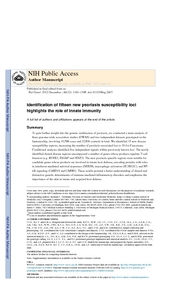Tsoi, LC;
Spain, SL;
Knight, J;
Ellinghaus, E;
Stuart, PE;
Capon, F;
Ding, J;
Li, Y;
Tejasvi, T;
Gudjonsson, JE;
et al.
Tsoi, LC; Spain, SL; Knight, J; Ellinghaus, E; Stuart, PE; Capon, F; Ding, J; Li, Y; Tejasvi, T; Gudjonsson, JE; Kang, HM; Allen, MH; McManus, R; Novelli, G; Samuelsson, L; Schalkwijk, J; Ståhle, M; Burden, AD; Smith, CH; Cork, MJ; Estivill, X; Bowcock, AM; Krueger, GG; Weger, W; Worthington, J; Tazi-Ahnini, R; Nestle, FO; Hayday, A; Hoffmann, P; Winkelmann, J; Wijmenga, C; Langford, C; Edkins, S; Andrews, R; Blackburn, H; Strange, A; Band, G; Pearson, RD; Vukcevic, D; Spencer, CC; Deloukas, P; Mrowietz, U; Schreiber, S; Weidinger, S; Koks, S; Kingo, K; Esko, T; Metspalu, A; Lim, HW; Voorhees, JJ; Weichenthal, M; Wichmann, HE; Chandran, V; Rosen, CF; Rahman, P; Gladman, DD; Griffiths, CE; Reis, A; Kere, J; Collaborative Association Study of Psoriasis (CASP); Genetic Analysis of Psoriasis Consortium; Psoriasis Association Genetics Extension; Wellcome Trust Case Control Consortium 2; Nair, RP; Franke, A; Barker, JN; Abecasis, GR; Elder, JT; Trembath, RC
(2012)
Identification of 15 new psoriasis susceptibility loci highlights the role of innate immunity.
Nature Genetics, 44 (12).
pp. 1341-1348.
ISSN 1546-1718
https://doi.org/10.1038/ng.2467
SGUL Authors: Markus, Hugh Stephen
![[img]](https://openaccess.sgul.ac.uk/107313/1.hassmallThumbnailVersion/Identification_fifteen_new_psoriasis_susceptibility_loci.pdf)  Preview |
|
["document_typename_application/pdf; charset=binary" not defined]
Accepted Version
Download (179kB)
| Preview
|
Abstract
To gain further insight into the genetic architecture of psoriasis, we conducted a meta-analysis of 3 genome-wide association studies (GWAS) and 2 independent data sets genotyped on the Immunochip, including 10,588 cases and 22,806 controls. We identified 15 new susceptibility loci, increasing to 36 the number associated with psoriasis in European individuals. We also identified, using conditional analyses, five independent signals within previously known loci. The newly identified loci shared with other autoimmune diseases include candidate genes with roles in regulating T-cell function (such as RUNX3, TAGAP and STAT3). Notably, they included candidate genes whose products are involved in innate host defense, including interferon-mediated antiviral responses (DDX58), macrophage activation (ZC3H12C) and nuclear factor (NF)-κB signaling (CARD14 and CARM1). These results portend a better understanding of shared and distinctive genetic determinants of immune-mediated inflammatory disorders and emphasize the importance of the skin in innate and acquired host defense.
| Item Type: |
Article
|
| Additional Information: |
Author’s manuscript is made available for academic research only, and cannot be used for commercial purposes without prior permission of the copyright holders. Made available here with permission from the publisher. |
| Keywords: |
CARD Signaling Adaptor Proteins, Core Binding Factor Alpha 3 Subunit, DEAD-box RNA Helicases, European Continental Ancestry Group, GTPase-Activating Proteins, Genetic Loci, Genetic Predisposition to Disease, Genome-Wide Association Study, Guanylate Cyclase, Humans, Immunity, Innate, Membrane Proteins, Oligonucleotide Array Sequence Analysis, Polymorphism, Single Nucleotide, Psoriasis, STAT3 Transcription Factor, Skin, T-Lymphocytes, Science & Technology, Life Sciences & Biomedicine, Genetics & Heredity, T-CELL DEVELOPMENT, GENOME-WIDE ASSOCIATION, GENE-EXPRESSION, CELIAC-DISEASE, TH17 DIFFERENTIATION, SIGNALING PATHWAYS, NEGATIVE REGULATOR, INTERFERON-GAMMA, COMMON VARIANTS, MULTIPLE COMMON, Developmental Biology, 11 Medical And Health Sciences, 06 Biological Sciences |
| Journal or Publication Title: |
Nature Genetics |
| ISSN: |
1546-1718 |
| Language: |
eng |
| Dates: |
| Date | Event |
|---|
| December 2012 | Published |
|
| Projects: |
| Project ID | Funder | Funder ID |
|---|
| 068545/Z/02 | Wellcome Trust | UNSPECIFIED | | 083948/Z/07/Z | Wellcome Trust | UNSPECIFIED | | 085475/B/08/Z | Wellcome Trust | UNSPECIFIED | | 085780 | Wellcome Trust | UNSPECIFIED | | 090532 | Wellcome Trust | UNSPECIFIED | | 098439 | Wellcome Trust | UNSPECIFIED | | 17552 | Arthritis Research UK | UNSPECIFIED | | AR054966 | NIAMS NIH HHS | UNSPECIFIED | | G0000934 | Medical Research Council | UNSPECIFIED | | G0601387 | Medical Research Council | UNSPECIFIED | | G060I1387 | Medical Research Council | UNSPECIFIED | | G0700314 | Medical Research Council | UNSPECIFIED | | HG007022 | NHGRI NIH HHS | UNSPECIFIED | | K08 AR057763 | NIAMS NIH HHS | UNSPECIFIED | | K08 AR060802 | NIAMS NIH HHS | UNSPECIFIED | | MR/J006742/1 | Medical Research Council | UNSPECIFIED | | R01 AR042742 | NIAMS NIH HHS | UNSPECIFIED | | R01 AR042742 | NIAMS NIH HHS | UNSPECIFIED | | R01 AR050266 | NIAMS NIH HHS | UNSPECIFIED | | R01 AR050266 | NIAMS NIH HHS | UNSPECIFIED | | R01 AR050511 | NIAMS NIH HHS | UNSPECIFIED | | R01 AR050511 | NIAMS NIH HHS | UNSPECIFIED | | R01 AR054966 | NIAMS NIH HHS | UNSPECIFIED | | RC1 AR058315 | NIAMS NIH HHS | UNSPECIFIED | | UNSPECIFIED | Canadian Institutes of Health Research | UNSPECIFIED |
|
| PubMed ID: |
23143594 |
| Web of Science ID: |
WOS:000311713200013 |
 |
Go to PubMed abstract |
| URI: |
https://openaccess.sgul.ac.uk/id/eprint/107313 |
| Publisher's version: |
https://doi.org/10.1038/ng.2467 |
Statistics
Item downloaded times since 30 Jan 2015.
Actions (login required)
 |
Edit Item |



